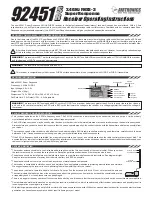
92451
2.4GHz FHSS-3
The new 92451 Super Response 2.4GHz FHSS-3 receiver is the fastest response (lowest latency) receiver Airtronics has ever offered. With a 2.5ms
response time, you will feel more connected to your model than with all other previous radio control systems. Combined with our specially made Super
Response servos (available separately), the 92451 Super Response receiver will give you reaction speeds like never before.
Receiver Operating Instructions
S
R
Due to the frame rate of the 92451 Super Response 2.4GHz FHSS-3 receiver, there are many older electronic radio control devices, such as ESC's and
analog servos, which will not work with this receiver. It is important to note that some analog servos will DAMAGE this receiver, therefore, analog servos
must NOT be used with this receiver. We have tested this receiver and found that many of the newest ESC's from LRP are 100% compatible, but many older
or off-brand ESC's may not be compatible with this receiver.
All modern digital servos will seemingly work BETTER with this receiver than any standard speed receiver. However, to completely take advantage
of this technology, you must use Airtronics Super Response servos to truly experience the superior response time.
Model: 92451 Super Response
Frequency: 2.4GHz FHSS-3
Input Voltage: 4.8v - 6.0v
Weight: 0.3oz (8.5gr)
Dimensions: 1.43 x 0.94 x 0.59in (36.5 x 24.0 x 15.0mm)
Fail Safe Limit: 3.8v Default / 3.5v - 5.0v Adjustable
Super Response
WARNING
This receiver is NOT equipped with BEC circuitry. DO NOT use a receiver battery any greater than 6.0 volts to power the receiver. Use only
a 4.8 volt to 6.0 volt receiver battery, an ESC with a BEC circuit that lowers the voltage to the receiver, or a voltage regulator that lowers the voltage to
the receiver.
receiver compatability - please read before use!
WARNING
This receiver will NOT work with analog servos of any kind. Do NOT use ANALOG servos with this product. IT WILL DAMAGE the receiver
and this damage will NOT be covered under warranty.
WARNING
This receiver is not compatible with all ESC's.
receiver information
Bind Button
Batt/DSC
CH 4 Auxiliary 2
CH 3 Auxiliary 1
CH 2 Throttle/ESC
CH1 Steering
= Signal
= Positive
= Negative
Bind LED
Coaxial Cable
Antenna
Reception Wire
l
This receiver operates on the 2.4GHz frequency band. The 2.4GHz connection is determined by the transmitter and receiver pair. Unlike ordinary
crystal-based systems, your model can be used without frequency control.
l
The 2.4GHz frequency band may be used by other devices, or other devices in the immediate area may cause interference on the same frequency band.
Always before use, conduct a bench test to ensure that the servos operate properly. Also, conduct checks with the transmitter as distant as possible from
your model.
l
The response speed of the receiver can be affected if used where multiple 2.4GHz radio controllers are being used, therefore, carefully check the area
before use. Also, if response seems slow during use, stop your model immediately and discontinue use.
l
If the 2.4GHz frequency band is saturated (too many radio controllers on at once), as a safety precaution, the radio control system may not bind. This
ensures that your radio control system does not get hit by interference. Once the frequencies have been cleared, or the saturation level has dropped, your
radio control system should be able to bind without any problems.
2.4GHz frequency band precautions
This receiver is compatible only with Airtronics FHSS-3 surface transmitters. It is not compatible with FHSS-2 or FHSS-1 transmitters.
l
The receiver antenna consists of a coaxial cable and a reception wire (the thin tip at the end of the coaxial cable). When you mount
the receiver antenna, do not bend the reception wire. Reception performance decreases if the reception wire is bent.
l
The antenna should be installed into a vertical plastic tube per your particular model's assembly instructions. See diagram at right.
Keep the receiver antenna as far away from the motor, battery, and ESC as possible.
l
The antenna should not come into contact with any carbon or metal chassis components.
l
The receiver is susceptible to vibration, shock, and moisture. Take appropriate measures to protect against vibration and moisture.
We suggest wrapping the receiver in shock-absorbing foam when installing it into your model.
l
The antenna is delicate, therefore, handle it with care. Do not pull on the antenna with force. Do not cut or extend the antenna.
l
The coaxial cable (the thicker portion or the antenna) can be bent into gentle curves, however, do not bend the coaxial cable acutely,
or repeatedly bend it, or the antenna core can be damaged.
l
There is a danger of runaway operation if connectors loosen during use. Make sure that the receiver, servo(s), and switch connectors are securely fitted.
l
Contact between metal parts mounted on a model can result in electrical noise, which can adversely effect receiver performance and possibly result in
runaway operation or damage to your model.
l
With electric-powered models, be sure to fit the motor with a noise suppression capacitor. Without a noise suppression capacitor, excessive electrical noise
generation can cause runaway operation and/or result in damage to your model.
receiver mountinG
Antenna Tube
Coaxial Cable
Antenna
Reception Wire




















